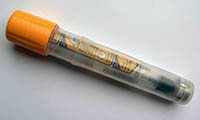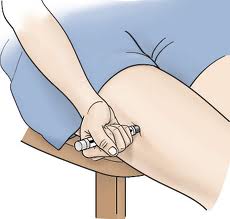




Allergy Anaphylaxis
 |
 |
 |
 |
 |
Someone with severe allergies can be at risk for a sudden, potentially life-threatening allergic reaction called anaphylaxis. This reaction can seem scary — a person may feel like his or her throat is closing or may faint, for example. But the good news is that, with the right action, it can be treated.
Anaphylaxis isn't common. But some people with allergies are more at risk than others. So if you have allergies (or a friend or family member does), it's good to know about anaphylaxis and be prepared.
Signs of Anaphylaxis
As with other allergies, anaphylaxis can trigger symptoms in any of these four body systems:
* skin
* gastrointestinal system
* respiratory system
* cardiovascular system
So how can people tell if an allergic reaction is actually an emergency? One clue is if it happens in two or more of these systems — hives on the skin, for example, together with stomach pain.
Here are the most common signs that a person who has been exposed to an allergen might have anaphylaxis:
* difficulty breathing
* tightness in the throat or feeling like the throat or airways are closing
* hoarseness or trouble speaking
* wheezing
* nasal stuffiness or coughing
* nausea, abdominal pain, or vomiting
* fast heartbeat or pulse
* skin itching, tingling, redness, or swelling
Dealing With a Serious Reaction
Anaphylaxis requires immediate treatment. It can get worse very quickly. If you have a known allergy and start to have a reaction, call 911 or immediately go to the nearest emergency room. Let friends know about your allergy so they can help you, if necessary.
During anaphylaxis, allergic chemicals are released into the blood. These cause the types of symptoms mentioned above. Doctors usually want people with life-threatening allergies to carry a medication called epinephrine. Epinephrine works by working against those symptoms. For example, it decreases swelling and raises blood pressure.
Because epinephrine has to get into the bloodstream as fast as possible in an emergency, it needs to be given in injection form. This isn't as scary as it sounds, though — there's no big needle and plunger involved. Instead, scientists have developed an auto injector about the size of a large pen that's easy to carry and use.
If you need to carry epinephrine, your doctor will show you how to use it. If you start to have difficulty breathing, tightness in your throat, or feel faint, or if you have allergic symptoms in more than one of the body systems mentioned above, it's time to give yourself epinephrine right away. You may want to take over-the-counter (OTC) antihistamines as well — but they won't work alone. OTC antihistamines are never a replacement for epinephrine in life-threatening reactions.
After using an epinephrine auto injector, go to a hospital emergency room immediately. Sometimes a person has a second wave of symptoms (called a biphasic reaction). So the hospital will observe you for at least 4 hours to be sure you are OK and to give you additional treatment, if needed.
Serious allergies can sound scary. But the good news is they're a lot easier to recognize and treat nowadays than in the past, thanks to greater awareness and the availability of epinephrine.
If you have a severe allergy to bee stings, foods, nut, or peanuts and require to have an Epi Pen, please print the linked form below and have it signed by your physician, parent and yourself. Then bring it into the nurse's office along with your Epi Pen.
Disclaimer: This information is not intended be a substitute for professional medical advice. It is provided for educational purposes only. You assume full responsibility for how you choose to use this information.
Reviewed by: Hemant P. Sharma, MD
Date reviewed: January 2008